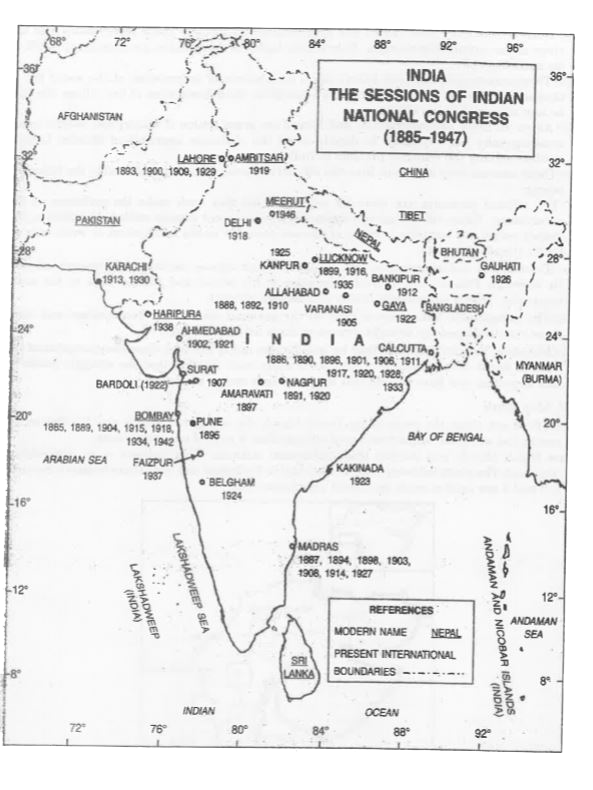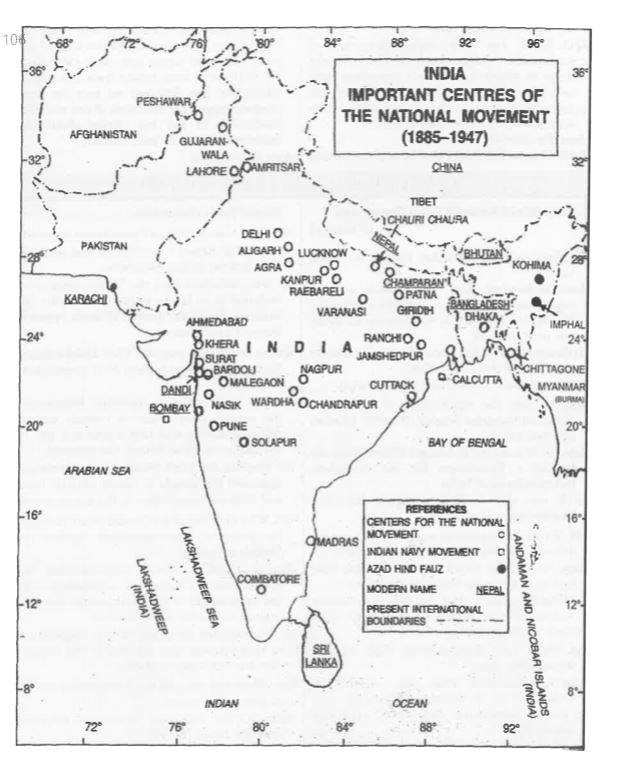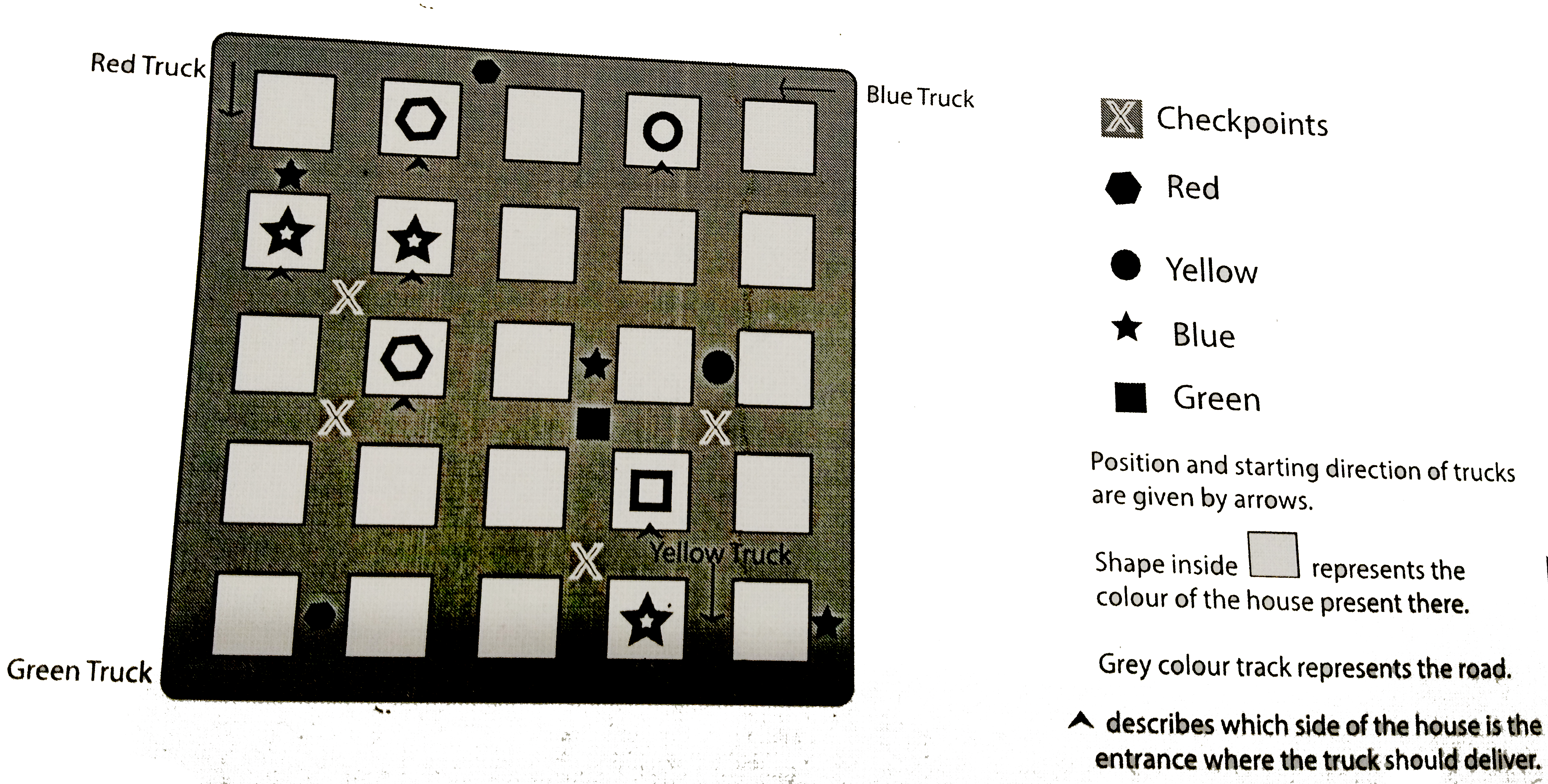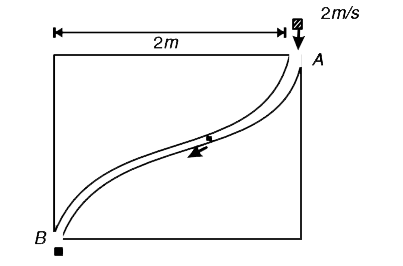Find out about the route of the Dandi March. On a map of Gujarat plot the line of the march and mark the major towns and villages that it passed along the route.
Dandi March was started from Sabarmati Ashram. This Ashram is in Ahmedabad (Gujarat). The route followed from Ahmedabad to Vadodara and from there to Surat. Squares 1, 2 and 3 are used to mark the Dandi expedition route.



Topper's Solved these Questions
- MAHATMA GANDHI AND THE NATIONALIST MOVEMENT CIVIL DISOBEDIENCE AND BEYOND BOOK - FULL MARKSCHAPTER - MAHATMA GANDHI AND THE NATIONALIST MOVEMENT CIVIL DISOBEDIENCE AND BEYOND EXERCISE - ADDITIONAL QUESTIONS SOLVED (I. Very Short Answer Type Questions)
29 Videos
- MAHATMA GANDHI AND THE NATIONALIST MOVEMENT CIVIL DISOBEDIENCE AND BEYOND BOOK - FULL MARKSCHAPTER - MAHATMA GANDHI AND THE NATIONALIST MOVEMENT CIVIL DISOBEDIENCE AND BEYOND EXERCISE - ADDITIONAL QUESTIONS SOLVED (II. Short Answer Type Questions)
15 Videos
- KINSHIP, CASTE AND CLASS EARLY SOCIETIES BOOK - FULL MARKSCHAPTER - KINSHIP, CASTE AND CLASS EARLY SOCIETIES EXERCISE - PREVIOUS YEARS BOARD QUESTIONS SOLVED
29 Videos
- PEASANTS, ZAMINDARS AND THE STATE BOOK - FULL MARKSCHAPTER - PEASANTS, ZAMINDARS AND THE STATE EXERCISE - Previous years board questions solved
24 Videos
Similar Questions
On the the map of China, mark and locate the main route of Long March.
View SolutionTo set a speed record in a measured ( straight-line) distance d, a race car must be driven first in one direction ( in time t1) and then in the opposite direction ( in time t2 ). (a) To eliminate the effects of the wind and obtain the car's speed vc in a windless situation, should we find the average of d/t1 and d/t2 ( method 1) or should we find divide d by the average of t1 and t2 ? (b) What is the fractional difference in the two methods when a steady wind blows along the car's route and the ratio of the wind speed vw to the car's speed vc is 0.0240 ?
View Solution
Knowledge Check
The Celts who lived in Britain before the Roman invasion of 43 AD could be said to have created the first towns. Celts in southern England lived in hill forts, which were quite large settlements. (Some probably had thousands of inhabitants). They were places of trade, where people bought and sold goods and also places where craftsmen worked. The Rom called them oppida.
However, the Rom created the first settlements that were undoubtedly towns. Roman towns were usually laid out in a grid pattern. In the centre was the forum or market place. It was lined with public buildings. Life in Roman towns was highly civilized with public baths and temples.
From the 5 century Angles, Saxons and Jutes invaded England. At first, the invaders avoided living in towns. However, as trade grew some towns grew up. London revived by the 7" century (although the Saxon town was, at first, outside the walls of the old Roman town). Southampton was founded at the end of the 7 century. Hereford was founded in the 8" century. Furthermore, Ipswich grew up in the 8 century and York revived.
However, towns were rare in Saxon England until the late 9 century. At that time, Alfred the Great created a network of fortified settlements across his kingdom called .burhs.. In the event of a Danish attack, men could gather in the local burh. However, burhs were more than forts. They were also market towns. Some burhs were started from scratch but many were created out of the ruins of old Roman towns. Places like Winchester rose, phoenix-like, from the ashes of history.
The thing that would strike us most about medieval towns would be their small size. Winchester, the capital of England, probably had about 8,000 people. At that time a .large. town, like Lincoln or Dublin had about 4,000 or 5,000 inhabitants and a .medium sized. town, like Colchester had about 2,500 people. Many towns were much smaller
However, during the 12 and 139 centuries most towns grew much larger. Furthermore, many new towns were created across Britain. Trade and commerce were increasing and there was a need for new towns. Some were created from existing villages but some were created from scratch. In those days you could create a town simply by starting a market. There were few shops so if you wished to buy or sell anything you had to go to a market. Once one was up and running, craftsmen and merchants would come to live in the area and a town would grow. What lay in the centre of Roman towns?AMarket placesBResidencesCTemplesDBathsYou are running out of time but have no idea about the route from Nepal to IIT Guwahati. The various cut-out parts of the map that can help you reach IIT Guwahati are hidden in the houses shown in the figure below. You will get the parts of the map only on delivering the right article(one per house) to all the houses.
(i) An ‘X’ coloured ARTICLE should be delivered to an ‘X’ coloured HOUSE only by using an ‘X’ coloured TRUCK.
(ii) A truck can also carry other coloured articles so that it can place them at any of the CHECKPOINTS from where other truck can later carry it to the destination.
(iii) Trucks can carry any number of articles at a time.
(iv) The main objective is to start all the trucks at the same time, with same speed and deliver the articles without collision of trucks. Also, a truck picks up every article that comes on its way.
(v) Last and the most importantly, the PATHS of the trucks should not overlap at any point other than junctions. At junctions, the paths can though cross each other (but both trucks should not reach that junction at same time which leads to collision). The trucks can move only forward.

Give the total number of articles carried by the red truck on it’s way.A1B2C3D4In the following questions, you have two passages with 5 questions in each passage. Read the passages carefully and choose the best answer to each question out of the four alternatives.
The savings of certain wild animals from extinction has for many years been a problem for zoologists and other specialists, but more recently the problem has become so acute, and has received so much publicity, that most people are now concenrned about it. This may at first seem strange because one of the most gratifying developments of the last few years has been the passing of strict laws to product wild animals and the consequent decline in the hunting of big - game for sport.
Why is it, then that some rare wild animals are still threatened with extinction and even some of the less rare ones are rapidly declining in numbr ?
One reason is the 'march of civilization'. When an area is wholly cleared of vegetation to make room for new towns, factory sites or hydroelectric plant the natural home of several species is destroyed, The displaced animal must either migrate to another area or perish. Even the clearing of land for a road or an airfield may involve 'pushing back' the jungle and the smaller the area in which wild animals complete for a living, the smaller the number that can hope to survive.
What is meant by 'pushing back the jungle'?ATo move jungle awayBTo complete for a livingCClearing of vegetation to make towns and factory sitesDRemoving the jungle
A square plate of side length 2m has a groove made in the shape of two quarter circles joining at the centre of the plate. The plate is free to rotate about vertical axis passing through its centre. The moment of inertia of the plate about this axis is 4kg−m2. A small block of mass 1 kg enters the groove at end A travelling with a velocity of 2/s parallel to the side of the square plate. The block move along the frictionless groove of the horizontal plate and comes out at the other end B with speed V. Find V assuming that width of the groove is negligible.

View SolutionRead the passage given and answer the questions that follow:
On 31 January 1930, Mahatma Gandhi sent a letter to Viceroy Irwin stating and imposing eleven demands. Among all the demands, the most stirring of all the demands was to abolish the salt tax that is consumed by the rich and the poor. The demands were needed to be fulfilled by 11 March or else the Congress will initiate a civil disobedience campaign. The popular salt march was started by Mahatma Gandhi and it was accompanied by 78 of his trusted volunteers. The march covered over 240 miles, from Gandhi's ashram in a place called Sabarmati to the Gujarati coastal town of Dandi. On 6 April he reached Dandi, and ceremonially violated the law, and started manufacturing salt by boiling seawater. This movement marked the beginning of the Civil Disobedience Movement
Which one of the following movement began with the Dandi March?
View SolutionRead the passage given and answer the questions that follow:
On 31 January 1930, Mahatma Gandhi sent a letter to Viceroy Irwin stating and imposing eleven demands. Among all the demands, the most stirring of all the demands was to abolish the salt tax that is consumed by the rich and the poor. The demands were needed to be fulfilled by 11 March or else the Congress will initiate a civil disobedience campaign. The popular salt march was started by Mahatma Gandhi and it was accompanied by 78 of his trusted volunteers. The march covered over 240 miles, from Gandhi's ashram in a place called Sabarmati to the Gujarati coastal town of Dandi. On 6 April he reached Dandi, and ceremonially violated the law, and started manufacturing salt by boiling seawater. This movement marked the beginning of the Civil Disobedience Movement
How much distance covered by M. K. Gandhi during Dandi March?
View SolutionRead the passage given and answer the questions that follow:
On 31 January 1930, Mahatma Gandhi sent a letter to Viceroy Irwin stating and imposing eleven demands. Among all the demands, the most stirring of all the demands was to abolish the salt tax that is consumed by the rich and the poor. The demands were needed to be fulfilled by 11 March or else the Congress will initiate a civil disobedience campaign. The popular salt march was started by Mahatma Gandhi and it was accompanied by 78 of his trusted volunteers. The march covered over 240 miles, from Gandhi's ashram in a place called Sabarmati to the Gujarati coastal town of Dandi. On 6 April he reached Dandi, and ceremonially violated the law, and started manufacturing salt by boiling seawater. This movement marked the beginning of the Civil Disobedience Movement
Identify the programmes of the Civil Disobedience Movement.
View SolutionRead the passage given and answer the questions that follow:
On 31 January 1930, Mahatma Gandhi sent a letter to Viceroy Irwin stating and imposing eleven demands. Among all the demands, the most stirring of all the demands was to abolish the salt tax that is consumed by the rich and the poor. The demands were needed to be fulfilled by 11 March or else the Congress will initiate a civil disobedience campaign. The popular salt march was started by Mahatma Gandhi and it was accompanied by 78 of his trusted volunteers. The march covered over 240 miles, from Gandhi's ashram in a place called Sabarmati to the Gujarati coastal town of Dandi. On 6 April he reached Dandi, and ceremonially violated the law, and started manufacturing salt by boiling seawater. This movement marked the beginning of the Civil Disobedience Movement
Which of the following statements are not true regarding the Gandhi-Irwin Pact of 1931?
View Solution
